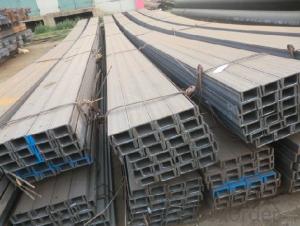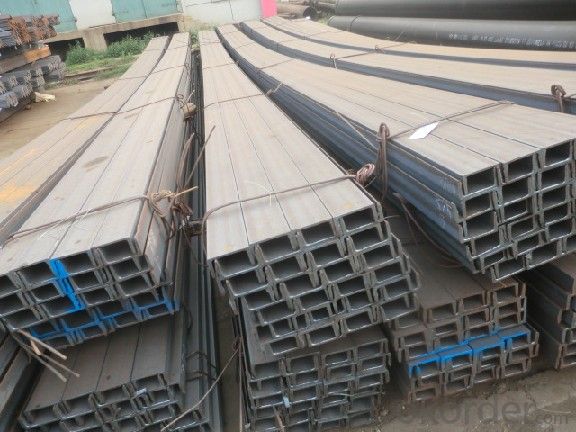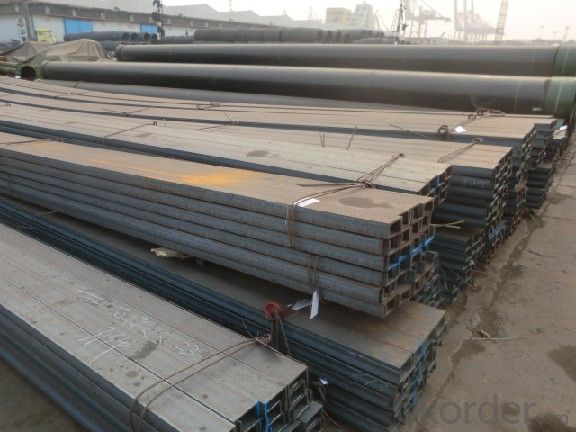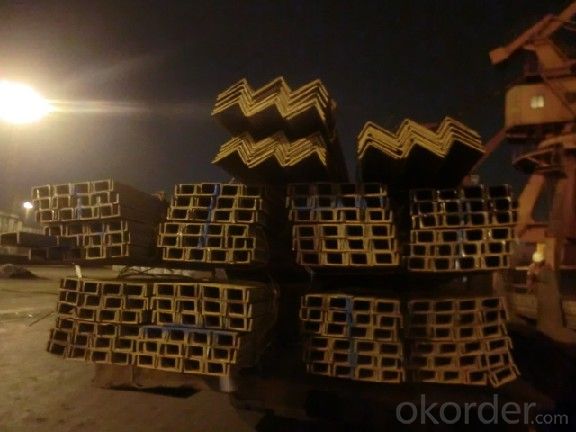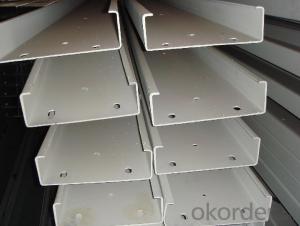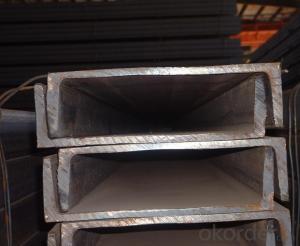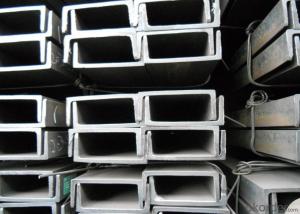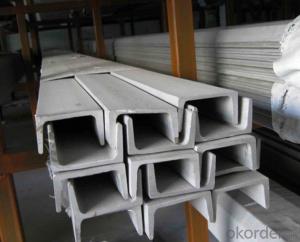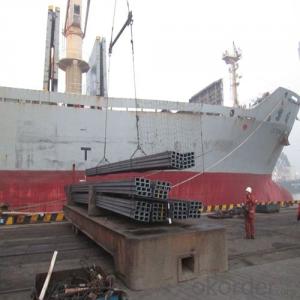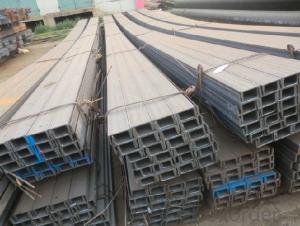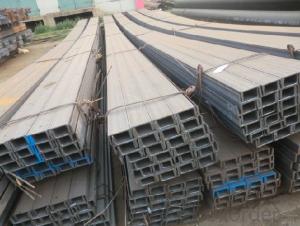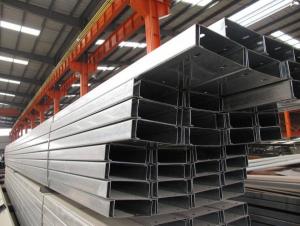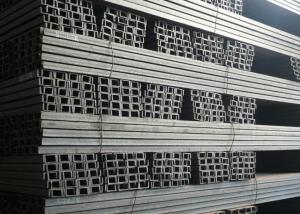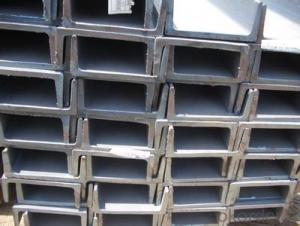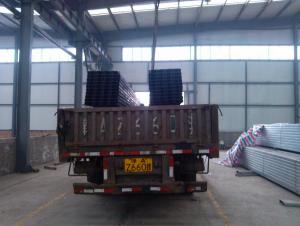hot channle and jis
- Loading Port:
- China Main Port
- Payment Terms:
- TT OR LC
- Min Order Qty:
- -
- Supply Capability:
- -
OKorder Service Pledge
OKorder Financial Service
You Might Also Like
Product Description:
Specifications of MS Channel:
1.We supply high quality MS Channel at reasonable price, including Chinese standard, Japanese standard and so on.
Standard | GB/JIS |
Material Grade | Q235,SS400 |
Technique: | Hot Rolled |
Sizes as per chinese standard: | 50*37*4.5mm - 300*89*11.5mm |
Sizes as per japanese standard: | 50*25*3mm – 200*80*7.5mm |
Length: | 6meter, 9meter, 12meter |
Note: 1.we are also competent to provide our customers other MS Channel based on other sizes according to customer’s requirements.
2. The length of our ms channel could be cut into other meters as per customer’s requirements. For example, the channel in 6meters could be cut into 5.8meters in order to be fit in the 20ft container.
2. The detailed sections of MS Channel as per GB standard.are shown in the table-1:
GB U CHANNEL | Standard | Sectional | Dimension |
| Mass: |
| (mm) | (mm) | (mm) | (mm) |
|
50X37 | 50 | 37 | 4.50 | 7.0 | 5.438 |
63X40 | 63 | 40 | 4.80 | 7.5 | 6.634 |
80x43 | 80 | 43 | 5.00 | 8.0 | 8.045 |
|
|
|
|
|
|
100x48 | 100 | 48 | 5.30 | 8.5 | 10.007 |
120x53 | 120 | 53 | 5.50 | 9.0 | 12.059 |
140x58 | 140 | 58 | 6.00 | 9.5 | 14.535 |
140x60 | 140 | 60 | 8.00 | 9.5 | 16.733 |
|
|
|
|
|
|
160x63 | 160 | 63 | 6.50 | 10.0 | 17.240 |
160x65 | 160 | 65 | 8.50 | 10.0 | 19.752 |
|
|
|
|
|
|
180x68 | 180 | 68 | 7.00 | 10.5 | 20.174 |
180x70 | 180 | 70 | 9.00 | 10.5 | 23.000 |
|
|
|
|
|
|
200x73 | 200 | 73 | 7.00 | 11.0 | 22.637 |
200x75 | 200 | 75 | 9.00 | 11.0 | 25.777 |
|
|
|
|
|
|
220x77 | 220 | 77 | 7.00 | 11.5 | 24.999 |
220x79 | 220 | 79 | 9.00 | 11.5 | 28.453 |
|
|
|
|
|
|
250x78 | 250 | 78 | 7.00 | 12.0 | 27.410 |
250x80 | 250 | 80 | 9.00 | 12.0 | 31.335 |
250x82 | 250 | 82 | 11.00 | 12.0 | 35.260 |
|
| |
|
|
|
280x82 | 280 | 82 | 7.50 | 12.5 | 31.427 |
280x84 | 280 | 84 | 9.50 | 12.5 | 35.823 |
280x86 | 280 | 86 | 11.50 | 12.5 | 40.219 |
|
|
|
|
|
|
300x85 | 300 | 85 | 7.50 | 13.5 | 34.463 |
300x87 | 300 | 87 | 9.50 | 13.5 | 39.173 |
300x89 | 300 | 89 | 11.50 | 13.5 | 43.883 |
Table-1
3. The chemical composition of HR Channel Steel according to Q235B is shown in Table-2.
Alloy No | Grade | Element(%) | ||||
C | Mn | S | P | Si | ||
Q235 | B | 0.12-0.20 | 0.3-0.7 | ≦0.045 | ≦0.045 | ≦0.3 |
Table-2
Note: we are able to present our customers relevant SGS test report for chemical composition of HR Channel Steel.
4. The mechanical property of HR Channel Steel according to Q235B is shown in Table-3-1 and Table-3-2
Alloy No | Grade | Yielding Strength Point(Mpa) | |||
Thickness(mm) | |||||
≦16 | >16-40 | >40-60 | >60-100 | ||
≧ | |||||
Q235 | B | 235 | 225 | 215 | 205 |
Table-3-1
Alloy No | Grade | Tensile Strength(Mpa) | Elongation After Fracture(%) | |||
| | Thickness(mm) | |||||
≦16 | >16-40 | >40-60 | >60-100 | |||
≧ | ||||||
G235 | B | 375-500 | 26 | 25 | 24 | 23 |
Table-3-2
Note: we are able to present our customers relevant SGS test report for mechanical property of MS Channel as customer’s request.
Applications of MS Channel:
The MS Channel can be applied to construction of warehouses, workshops, sport stadiums and car parks etc.The hot rolled channel steel belongs to carbon structural steel which is applied to in the field of construction and machinery.In details, the hot rolled channel steel is usually used for arch-itechtural structure, and they could be welded in order to support or hang a vari-ety of facilities. They are also usually used in combination with I beam. Generally,the hot rolled channel steel we supply must possess perfect welding property, riveting property and mechanical property and so on.
Package & Delivery of MS Channel:
1.The hot rolled channel steel will be packed in bundle with steel wire at each end of every bundle and color marking in order to help the customer to recognize his goods more easily at sight.
2. And the hot rolled channel steel could be loaded into 20ft or 40ft container, or by bulk cargo.If the weight of each bundle reaches more than 3.5 mt, the loading by break bulk cargo should be choosed.When the weight of each bundle reaches less than 3mt, the loading by container should be choosed.
3.As for the transportaion from mill to loading port, the truck will be usually used. And the maximum quantity for each truck is 40mt.
4.All in all, we could do in accordance with customer's request
- Q: Can steel channels be used for cable tray systems?
- Yes, steel channels can be used for cable tray systems. Steel channels offer strength, durability, and resistance to corrosion, making them suitable for supporting and organizing cables in a cable tray system.
- Q: Can steel channels be used for pedestrian bridges?
- Indeed, pedestrian bridges can utilize steel channels. The utilization of steel channels is widespread in the construction of bridges owing to their robustness, longevity, and adaptability. They possess remarkable load-bearing capabilities, thus ensuring the secure passage of pedestrians across the bridge. It is possible to tailor the design and fabrication of steel channels to meet specific bridge necessities, including span length, weight capacity, and aesthetic considerations. Furthermore, steel channels exhibit resilience against harsh environmental conditions, rendering them suitable for open-air pedestrian bridges that may be subjected to various weather elements. On the whole, due to their structural soundness and capacity to provide a secure and dependable crossing for pedestrians, steel channels remain a favored option in the construction of pedestrian bridges.
- Q: What is the difference between channel steel and C steel?
- Channel steel is produced by hot rolling, supplied directly by iron and steel works, and thicker
- Q: What are the different steel channel profiles available?
- There are several different steel channel profiles available, each with its unique characteristics and applications. Some of the commonly used steel channel profiles include C-channel, U-channel, Z-channel, and Hat-channel. C-channel, also known as American Standard Channel (ASC), is a versatile profile that is widely used in construction and structural applications. It has a straight web and flanges of equal length, forming a C-shaped cross-section. C-channels are often used for beams, columns, and purlins in building frames. They can also be used as a support for metal decking or as a base for overhead doors. U-channel, also known as a U-beam or American Standard Channel (ASC), has a U-shaped cross-section with flanges that are shorter than the web. U-channels are commonly used for applications requiring additional strength and stability, such as bracing, framework, and support structures. They are also used in the automotive industry for truck beds, trailers, and vehicle frames. Z-channel, also known as Zee or Zed, has a Z-shaped cross-section with two flanges and a web connecting them. Z-channels are often used in construction for applications where two pieces need to be joined together, such as wall studs, roof framing, and floor joists. They can also be used as a support for wall panels or cladding systems. Hat-channel, also known as furring channel, is a thin-gauge steel profile with a wide, flat top and two short, parallel legs. Hat-channels are commonly used as a support for drywall or other types of cladding materials in ceiling and wall applications. They provide a secure and stable base for attaching panels and can help improve soundproofing and insulation in buildings. These are just a few examples of the different steel channel profiles available in the market. The choice of profile depends on the specific application requirements, such as load-bearing capacity, structural stability, and compatibility with other building components. It is important to consult with a structural engineer or supplier to determine the most suitable steel channel profile for a particular project.
- Q: What is the cost of steel channels compared to other materials?
- The price of steel channels can vary based on several factors, including the type and grade of steel, market demand, and location. Generally, steel channels are more expensive than materials like wood or aluminum, but they can be more cost-effective than stainless steel or titanium. Steel channels have numerous advantages that justify their higher cost. They are known for their strength, durability, and corrosion resistance, making them suitable for various applications in construction, manufacturing, and infrastructure projects. Steel channels also have excellent load-bearing capabilities, allowing them to support heavy loads and withstand extreme conditions. Furthermore, steel channels are readily available in standard sizes and can be easily obtained from local suppliers or manufacturers. This accessibility contributes to lower transportation costs compared to materials that may need to be imported. It is important to note that the cost of steel channels can also be influenced by market fluctuations, such as changes in raw material prices or tariffs. Therefore, conducting thorough research and obtaining quotes from different suppliers is essential to accurately understand the current cost of steel channels in relation to other materials.
- Q: What are the factors to consider when determining the appropriate width of a steel channel?
- When determining the appropriate width of a steel channel, several factors need to be considered. Firstly, the load-bearing capacity of the channel is crucial. The width of the channel should be sufficient to support the expected load without bending or buckling. The weight and distribution of the load, as well as any dynamic forces or vibrations, should be taken into account while calculating the required width. Secondly, the span length or distance between the supports is an important factor. Longer spans require wider channels to provide adequate support and prevent sagging or deflection. Thirdly, the material properties of the steel channel need to be considered. The strength and stiffness of the material influence the required width. Using steel with higher tensile strength or a higher modulus of elasticity may allow for narrower channel widths while maintaining the necessary structural integrity. Additionally, the intended use or application of the steel channel should be considered. Different applications may have specific requirements for the width of the channel. For example, in building construction, the width of steel channels used for beams or columns would be determined by structural design codes and standards. Furthermore, the fabrication and installation processes should be taken into account. The width of the steel channel should be practical for manufacturing, transportation, and installation purposes. It should be feasible to produce the desired width within the capabilities of the steel manufacturer, and it should be manageable to transport and erect the channel at the construction site. Lastly, cost considerations play a role in determining the appropriate width of a steel channel. Wider channels generally require more material, resulting in higher costs. However, using a narrower channel than required may compromise the structural integrity and safety, which may lead to additional costs in the long run. In conclusion, the factors to consider when determining the appropriate width of a steel channel include the load-bearing capacity, span length, material properties, intended use, fabrication and installation processes, and cost considerations. By carefully evaluating these factors, an appropriate width can be determined to ensure the structural integrity and functionality of the steel channel.
- Q: Are steel channels suitable for architectural feature elements?
- Yes, steel channels can be suitable for architectural feature elements. Steel channels are versatile and can be used in a variety of architectural applications. They are known for their strength, durability, and ability to support heavy loads, making them a popular choice for structural elements in buildings. In architectural design, steel channels can be used to create unique and visually appealing features. They can be incorporated into building facades, staircases, handrails, and other decorative elements. Steel channels can be customized to different shapes and sizes, allowing architects to create intricate and complex designs. Furthermore, steel channels can be finished in various ways to enhance their aesthetic appeal. They can be painted, powder-coated, or even left exposed for a more industrial look. The versatility in finishes allows architects to achieve the desired visual effect for their architectural feature elements. Another advantage of using steel channels is their ability to withstand harsh weather conditions and resist corrosion. This makes them suitable for both indoor and outdoor architectural applications. Steel channels are also low maintenance, which is an added advantage for architectural features that may be difficult to access for regular upkeep. Overall, steel channels offer a combination of strength, durability, and design flexibility, making them a suitable choice for architectural feature elements. Their ability to support heavy loads, versatility in design, and resistance to weather make them a reliable and long-lasting option for creating visually appealing architectural features.
- Q: What do you mean by "A" in the channel type?
- The same waist height, according to its thickness is divided into a, B, B, C or a.A thin waist is the most.The width of their legs is equal to the waist thickness difference, that is, the real leg (not including waist thickness) is the same length, and the average leg thickness is the same.
- Q: How do steel channels contribute to the stability of a structure during tornadoes?
- Steel channels contribute to the stability of a structure during tornadoes in several ways. Firstly, steel channels are made of high-strength steel, which provides excellent resistance to both compression and tension forces. This strength allows the channels to withstand the powerful winds and forces that tornadoes generate. Moreover, steel channels are often used as structural members in the framing of a building. They are typically installed vertically or horizontally between the main columns and beams, creating a network of interconnected support. This framework helps distribute the load and forces generated by the tornado throughout the structure, preventing concentrated stress points and potential collapses. Additionally, steel channels can be strategically placed in load-bearing walls or as bracing elements to enhance the structural integrity of a building. These channels act as reinforcements, providing extra support and stiffness to the walls, which is crucial during tornadoes when the structure is subjected to intense wind pressures. This reinforcement helps to prevent the walls from buckling or collapsing under the extreme forces. Furthermore, steel channels are often utilized in the construction of storm shelters or safe rooms, which are specifically designed to protect occupants during tornadoes. These channels are incorporated into the walls, ceiling, and floor of these shelters, providing a robust and secure enclosure that can withstand the destructive forces of a tornado. Overall, steel channels play a crucial role in enhancing the stability of a structure during tornadoes. Their high strength, ability to distribute forces, and reinforcement capabilities make them an essential component in ensuring the safety and integrity of buildings in tornado-prone areas.
- Q: How do steel channels contribute to building aesthetics?
- Building aesthetics can be enhanced in several ways by incorporating steel channels. Firstly, these channels serve as structural elements, providing strength and stability to the overall structure. However, they also play a significant role in improving the visual appeal of a building. One of the primary ways steel channels contribute to building aesthetics is through their sleek and contemporary appearance. With their clean lines and smooth surface, steel channels can give a building a modern and sophisticated look. They can be utilized in a range of architectural designs, from industrial to minimalist, adding a touch of elegance and refinement to the overall aesthetic. Furthermore, steel channels offer great versatility in terms of design possibilities. Architects and designers can easily customize and fabricate them into various shapes and sizes, allowing for the creation of unique and visually striking elements. Steel channels can be employed as decorative features like handrails, balustrades, or window frames, thereby adding visual interest and architectural detailing to the building. Moreover, steel channels can be finished with different coatings or treatments to further enhance their aesthetic appeal. They can be painted in various colors to complement the overall design scheme or left exposed, showcasing the natural beauty of steel. Additionally, they can be polished or brushed to achieve different textures and finishes, thereby adding depth and character to the building's appearance. Furthermore, steel channels can contribute to the aesthetics of a building by creating a sense of openness and transparency. When used as structural elements in facades, they can support large glass panels, allowing for expansive views and the entry of natural light into the building. This creates a visually pleasing and inviting atmosphere, connecting the interior spaces with the surrounding environment. In conclusion, steel channels enhance building aesthetics by providing a sleek and contemporary appearance, offering design versatility, enabling customization, and creating a sense of openness. With their clean lines, smooth surface, and various finishing options, steel channels can elevate the visual appeal of a building, adding elegance, sophistication, and architectural detailing to the overall design.
Send your message to us
hot channle and jis
- Loading Port:
- China Main Port
- Payment Terms:
- TT OR LC
- Min Order Qty:
- -
- Supply Capability:
- -
OKorder Service Pledge
OKorder Financial Service
Similar products
Hot products
Hot Searches
Related keywords
